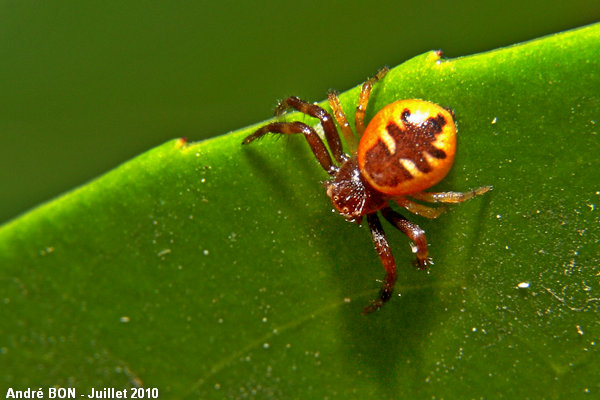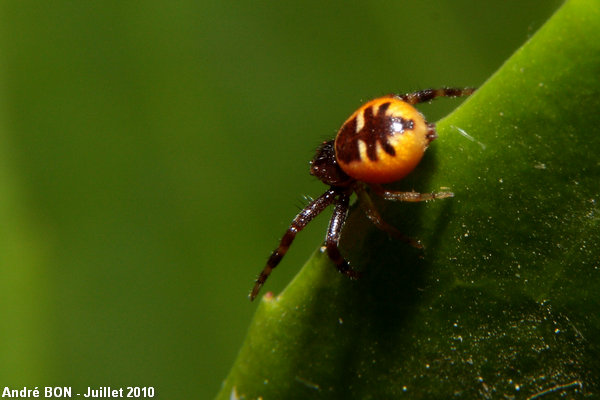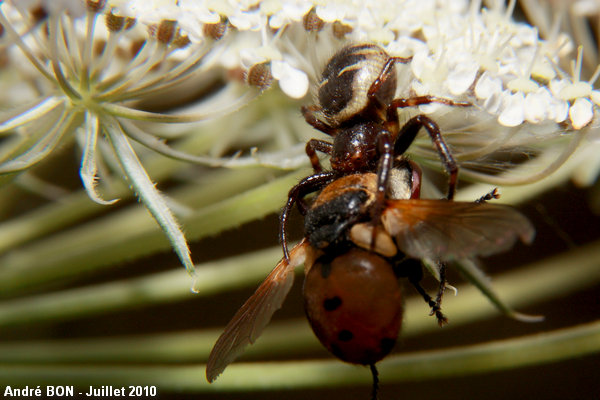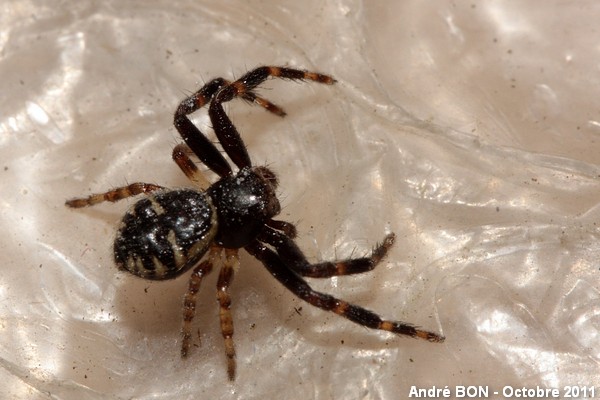






| Synaema globosum (Fabricius, 1775) |







|
|
Scientific name: Synaema globosum (Fabricius, 1775) Common name: French name: Araignée Napoléon, Thomise globuleux Order: Araneae Family: Thomisidae Size: Body size: 7 to 8 mm for females; 2 to 4 mm for males. Biotope: Flower meadows, road sides, woodland edges. Synaema globosum sits in wait on flowers to capture insects. Web: No web. Observation period: May to August. Geographic area: Southern part of the Palearctic region. |
Synaema globosum shows dark brown to black cephalothorax and legs. The two fore leg pairs, used to chase insects coming to gather nectar on flowers, are much longer than the two hind leg pairs which are rather used for locomotion. The abdomen shows a black pattern on a variable ground colour which may be white, yellow, orange or red. These variations allow some kind of camouflage on different kind of flowers. The shape of the mark on the upper side of the abdomen looks like the silhouette of Napoléon. This is the origin of the French common name for this species. Synaema globosum sits in wait on flowers and can capture preys which are rather large compared to its own size. |
| [To know more about the Synaema globosum] [Next picture] [Top] |

|
I have observed this Synaema globosum while I was collecting the leaves following the trimming of the laurel hedgerow. It has a very discrete presence in the garden as this is my very first observation of this species here. |
| [To know more about the Synaema globosum] [Next picture] [Previous picture] [Top] |

|
I have shot a few pictures then I have managed that this Synaema globosum returns back to the hedgerow before carrying the leaves to the municipal compost facility. |
| [To know more about the Synaema globosum] [Next picture] [Previous picture] [Top] |

|
There are many insects on the umbelliferae flowers on this hot day of July. No diet in the short term for Synaema globosum. |
| [To know more about the Synaema globosum] [Next picture] [Previous picture] [Top] |

|
Synaema globosum catches the prey behind the neck. Then it injects venom with instantaneous effect. The size of the preys sometimes exceeds the size of the spider. |
| [To know more about the Synaema globosum] [Next picture] [Previous picture] [Top] |

|
Here is one male. They are much smaller than females. This is very common with spiders. So I have not told this species apart on the first view but later on the picture. |
| [To know more about the Synaema globosum] [Next picture] [Previous picture] [Top] |

|
I have found this Synaema globosum on my terrace while I was moving the garden furniture into the house for winter. I have used extension tubes to decrease the minimum focus distance and then obtain a higher magnification. |
| [To know more about the Synaema globosum] [Previous picture] [Top] |

|
I have read that adults are observed from May to August. This observation appears rather late in the season. |